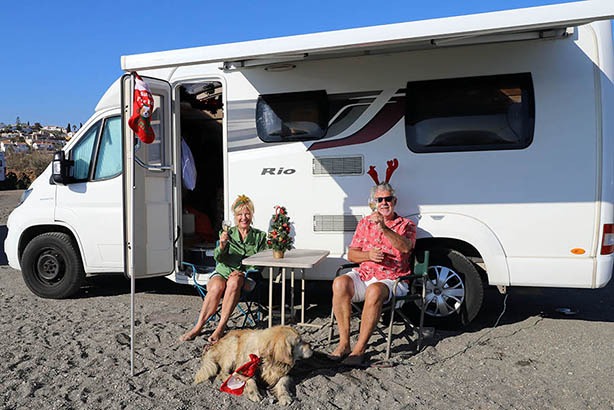search
date/time
 | Cumbria Times A Voice of the Free Press |

Sharon Cain
Features Editor
12:00 AM 1st September 2025
travel
European Travel: How To Avoid Being Fined, Banned Or Deported

Festive Brexit: Sharon, Steve and Bracken Images by Steve Hare
However, since January 1, 2021, when Britain momentously ‘Brexited’ from the EU, reveries of halcyon border-hopping days are tempered with stringent restrictions to avoid Brits outstaying their welcome.
In the latest Motoring article, Features Editor, Sharon Cain, who travels extensively with photographer, Steve Hare, and golden retriever, Bracken, shares how they explored fifteen European countries without falling foul of Brexit laws.
Why Every Day Counts
To say the implications of Brexit on British travellers have been far reaching is beyond an understatement.
Like many couples, our pre-Brexit dream was heading to the sun and new cultures by land, sea and air to escape harsh English winters and Northumberland’s raging North Sea.
When the United Kingdom voted to leave the European Union in 2016, many of us were oblivious to the degree that the new rules would impose on our freedoms to work and travel in Europe.
As Brexit laws stand, Brits can only stay 90 days within any 180-day period within what is called the Schengen Zone – an area spanning 450 people and 29 countries that have officially abolished controls at their common borders.
To add to the complexity, not all the countries in the zone are members of the European Union.
Every day counts towards the 90-day limit - and a quick hop by plane to Paris for a weekend, or a sun-soaked ten-day break in the Med all add up.

Beach park up on the Peloponnese, Greece
The second rule is to make sure your passports are stamped on entering and leaving the zone.
With all this in mind, how could we explore fifteen countries on a single trip - a nigh on impossible feat in just short of 13 weeks under Brexit rules - without being banned, fined or, the worst possible ignominy, being deported?
The Schengen Shuffle

Berat in Albania is not in Schengen or the EU
We set off on a Schengen Shuffle that would see us dip in and out of Schengen and non-Schengen countries - where the 90-day rule does not apply.
Where To Roam In The Schengen Zone?

Saumur sunset on the Loire: Days in France also count
Whichever way you venture in and out of Europe, try to avoid last minute stress by leaving it to your last day to book a return flight or ferry, especially if you are racing across France or Spain bound for the Eurotunnel or channel ferries.
The zone includes popular destinations like France - from where our European journeys usually start after embarking on ferries from the South of England - along with Switzerland, Greece, Italy, Portugal, and Spain.

Divine: Liechtenstein on The Rhine – not in EU but in Schengen
One of the world’s smallest countries nestled between Austria and Switzerland, Liechtenstein’s royal family live in its fairy tale castle, and throw a party every year for the country’s 39,000 residents.
Located on the Rhine Valley, its backdrop is breathtaking.

Ireland’s Slieve League Cliffs, the highest cliffs in Europe
To add to the minefield, it is not just EU countries which are subject to the 90-day countdown.
All member states of the European Free Trade Association, namely Iceland, Liechtenstein, Norway, and Switzerland, have signed association agreements with the EU to be part of the Schengen Area.
The four microstates of Andorra, Monaco, San Marino, and Vatican City are also included.
Spending 24 hours in these states (not that you can stopover in The Vatican!) does not gain you any extra days.
Ireland which opted out of the Schengen Area and retains border checks, enables freedom of travel - which we took advantage of.
Catching the ferry from Holyhead to Dublin was the start of our mega motorhome trip on the Wild Atlantic Way – a 1,600-kilometre West coast adventure which lives up to its name.

Picture postcard: Kinsale in Cork

Irish magic: Captivating colours of Connemara
When planning your travels, it is important to keep a check on new countries entering the EU to avoid getting caught out.
If you want to spend a few months in Cyprus, go now before restrictions kick in as the country is set to join the union by 2026.
Northern Cyprus, while not subjected to EU or Schengen restrictions, presents a completely different but complex scenario, complicated by the occupation of Northern Cyprus by Türkiye since 1974.

The Turkish army maintains a strong force in Northern Cyprus
Exploring the North, which has a strong military presence, was a fascinating and thought provoking experience which we’d highly recommend and will include more about in future articles.
EU member countries which are not in the Schengen Zone and exempt from the the 90-day rule include Bulgaria and Romania.
Also exempt are countries outside both the EU and the Schengen Zone such as Türkiye, Morocco, Georgia, Moldova, Serbia, Bosnia and Herzegovina, and Albania.
Countdown To New Entry/Exit Regulations
Whichever countries you decide upon, winging your travel days and hoping for the best is not an option.
A new Entry/Exit System (EES), which comes into force on October 12, 2025, uses automated tallying of your days when scanning your passport on leaving the zone.
Have your fingerprints and your photo taken
Answer the Schengen Border Code questions
If you enter the Schengen area through the Port of Dover, Eurotunnel at Folkestone or St Pancras International, this information will be taken at the border before you leave the UK.
Passport Checks

Have a ‘date of issue’ less than 10 years before the date you arrive – if you renewed your passport before 1 October 2018, it may have a date of issue that is more than 10 years ago
Have an ‘expiry date’ at least 3 months after the date you plan to leave the Schengen area (the expiry date does not need to be within 10 years of the date of issue)
Be stamped on entry and exit of the Schengen area.
Check out the free European Commission short stay calculator that enables travellers to check the maximum length of a stay in the future Schengen 90/180-Day Calculator & Re-Entry Planner - HelloSchengen
Helpful information on restrictions and requirements can be found on the Government website Travelling to the EU and Schengen area
Rule-breaking Penalties

Venetian dreams: Grand Canal campsite – but don’t outstay your welcome
Think how far and wide a jaw-dropping €10,000 would take your wanderlust - and stick to the rules, however frustrating - to fulfil your voyages of self-discovery.
We travel not to escape life but for life not to escape us